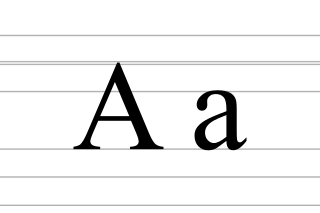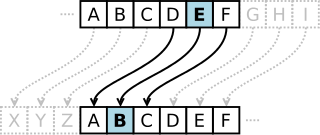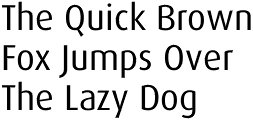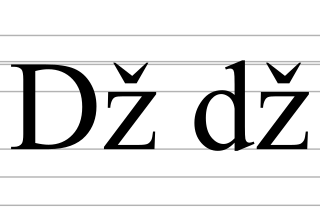
A, or a, is the first letter and the first vowel letter of the Latin alphabet, used in the modern English alphabet, and others worldwide. Its name in English is a, plural aes.

D, or d, is the fourth letter of the Latin alphabet, used in the modern English alphabet, the alphabets of other western European languages and others worldwide. Its name in English is dee, plural dees.
The Hebrew alphabet, known variously by scholars as the Ktav Ashuri, Jewish script, square script and block script, is traditionally an abjad script used in the writing of the Hebrew language and other Jewish languages, most notably Yiddish, Ladino, Judeo-Arabic, and Judeo-Persian. In modern Hebrew, vowels are increasingly introduced. It is also used informally in Israel to write Levantine Arabic, especially among Druze. It is an offshoot of the Imperial Aramaic alphabet, which flourished during the Achaemenid Empire and which itself derives from the Phoenician alphabet.

The International Phonetic Alphabet (IPA) is an alphabetic system of phonetic notation based primarily on the Latin script. It was devised by the International Phonetic Association in the late 19th century as a standard written representation for the sounds of speech. The IPA is used by lexicographers, foreign language students and teachers, linguists, speech–language pathologists, singers, actors, constructed language creators, and translators.

Q, or q, is the seventeenth letter of the Latin alphabet, used in the modern English alphabet, the alphabets of other western European languages and others worldwide. Its name in English is pronounced, most commonly spelled cue, but also kew, kue and que.
Transliteration is a type of conversion of a text from one script to another that involves swapping letters in predictable ways, such as Greek ⟨α⟩ → ⟨a⟩, Cyrillic ⟨д⟩ → ⟨d⟩, Greek ⟨χ⟩ → the digraph ⟨ch⟩, Armenian ⟨ն⟩ → ⟨n⟩ or Latin ⟨æ⟩ → ⟨ae⟩.

V, or v, is the twenty-second letter of the Latin alphabet, used in the modern English alphabet, the alphabets of other western European languages and others worldwide. Its name in English is vee, plural vees.

Z, or z, is the twenty-sixth and last letter of the Latin alphabet. It is used in the modern English alphabet, in the alphabets of other Western European languages, and in others worldwide. Its usual names in English are zed, which is most commonly used in International English and zee, only used in American, sometimes Canadian and Caribbean English and with an occasional archaic variant izzard.

In cryptography, a Caesar cipher, also known as Caesar's cipher, the shift cipher, Caesar's code, or Caesar shift, is one of the simplest and most widely known encryption techniques. It is a type of substitution cipher in which each letter in the plaintext is replaced by a letter some fixed number of positions down the alphabet. For example, with a left shift of 3, D would be replaced by A, E would become B, and so on. The method is named after Julius Caesar, who used it in his private correspondence.

Modern English is written with a Latin-script alphabet consisting of 26 letters, with each having both uppercase and lowercase forms. The word alphabet is a compound of alpha and beta, the names of the first two letters in the Greek alphabet. Old English was first written down using the Latin alphabet during the 7th century. During the centuries that followed, various letters entered or fell out of use. By the 16th century, the present set of 26 letters had largely stabilised:

Alphabetical order is a system whereby character strings are placed in order based on the position of the characters in the conventional ordering of an alphabet. It is one of the methods of collation. In mathematics, a lexicographical order is the generalization of the alphabetical order to other data types, such as sequences of numbers or other ordered mathematical objects.
The affine cipher is a type of monoalphabetic substitution cipher, where each letter in an alphabet is mapped to its numeric equivalent, encrypted using a simple mathematical function, and converted back to a letter. The formula used means that each letter encrypts to one other letter, and back again, meaning the cipher is essentially a standard substitution cipher with a rule governing which letter goes to which. As such, it has the weaknesses of all substitution ciphers. Each letter is enciphered with the function (ax + b) mod 26, where b is the magnitude of the shift.
The Greek alphabet has been used to write the Greek language since the late 9th or early 8th century BC. It is derived from the earlier Phoenician alphabet, and was the earliest known alphabetic script to have distinct letters for vowels as well as consonants. In Archaic and early Classical times, the Greek alphabet existed in many local variants, but, by the end of the 4th century BC, the Euclidean alphabet, with 24 letters, ordered from alpha to omega, had become standard and it is this version that is still used for Greek writing today.
Several manual alphabets in use around the world employ two hands to represent some or all of the letters of an alphabet, usually as a part of a deaf sign language. Two-handed alphabets are less widespread than one-handed manual alphabets. They may be used to represent the Latin alphabet or the Cyrillic alphabet.

Dž is the seventh letter of the Gaj's Latin alphabet for Serbo-Croatian, after D and before Đ. It is pronounced. Dž is a digraph that corresponds to the letter Dzhe (Џ/џ) of the Serbian Cyrillic alphabet. It is also the tenth letter of the Slovak alphabet. Although several other languages also use the letter combination DŽ, they treat it as a pair of the letters D and Ž, not as a single distinct letter.
In a writing system, a letter is a grapheme that generally corresponds to a phoneme—the smallest functional unit of speech—though there is rarely total one-to-one correspondence between the two. An alphabet is a writing system that uses letters.

Ɗ, known as D with hook, is a letter of the Latin alphabet. The lower case, represents a voiced dental implosive or a voiced alveolar implosive in the International Phonetic Alphabet. It is used with the same value in the orthographies of various languages, notably some African languages, such as Fula and Hausa, also in Sindhi and used in Shona from 1931 to 1955.
The Hawaiian alphabet is an alphabet used to write Hawaiian. It was adapted from the English alphabet in the early 19th century by American missionaries to print a bible in the Hawaiian language.

B, or b, is the second letter of the Latin alphabet, used in the modern English alphabet, the alphabets of other western European languages and others worldwide. Its name in English is bee, plural bees.
The goal of braille uniformity is to unify the braille alphabets of the world as much as possible, so that literacy in one braille alphabet readily transfers to another. Unification was first achieved by a convention of the International Congress on Work for the Blind in 1878, where it was decided to replace the mutually incompatible national conventions of the time with the French values of the basic Latin alphabet, both for languages that use Latin-based alphabets and, through their Latin equivalents, for languages that use other scripts. However, the unification did not address letters beyond these 26, leaving French and German Braille partially incompatible and as braille spread to new languages with new needs, national conventions again became disparate. A second round of unification was undertaken under the auspices of UNESCO in 1951, setting the foundation for international braille usage today.












